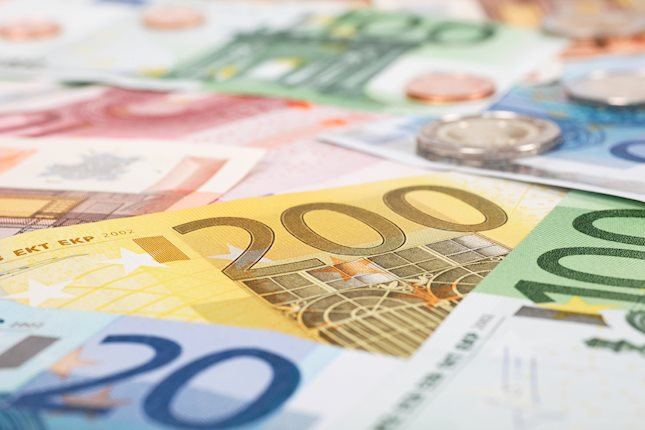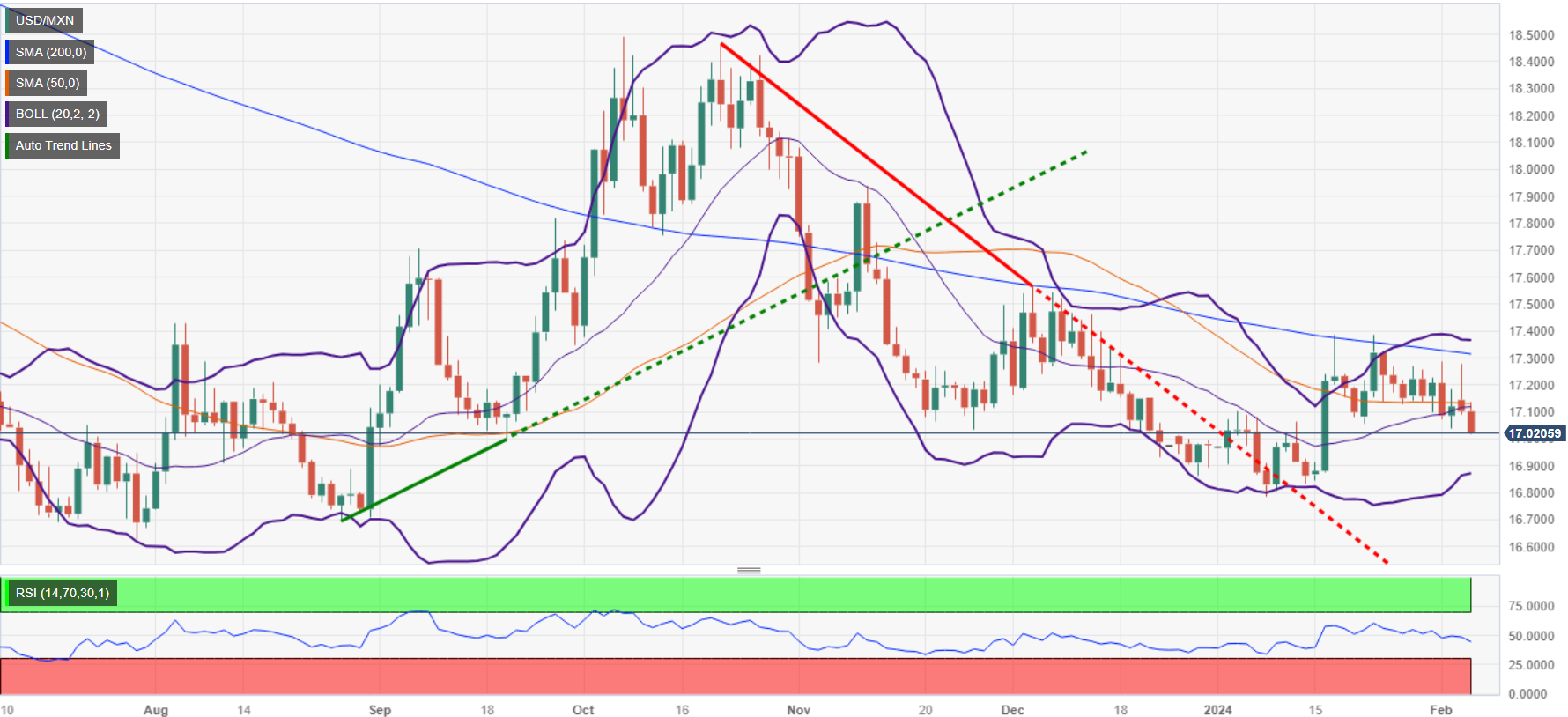- Mexican Peso gains, driven by a soft US Dollar due to lower US Treasury yields.
- Market anticipates Consumer Confidence, auto data and Banxico's rate decision.
- Powell's rate cut remarks prompt cautious trading; speeches by Fed's Mester, Kashkari, Collins in focus.
The Mexican Peso (MXN) advanced against the US Dollar (USD) in early trading during the North American session as US Treasury bond yields edged lower, a headwind for the Greenback. A risk-on impulse, as witnessed by Wall Street posting gains, is a tailwind for the Mexican currency. Traders await inflation figures and the Bank of Mexico (Banxico) monetary policy meeting on Thursday. The USD/MXN exchanges hands at 17.05, down 0.34%.
Mexico´s economic calendar will gather some steam on Wednesday with the release of Consumer Confidence data. Then automobile industry data arrives on Wednesday. By Thursday, Banxico will get an early update on inflation ahead of their decision. The central bank will hold rates unchanged, most analysts predict.
Meanwhile, Federal Reserve (Fed) Chair Jerome Powell said the US central bank is in no rush to cut rates, instead reassuring the majority of Fed officials to expect three rate cuts. Ahead in the day, traders will get cues from Loretta Mester, Neil Kashkari and Susan Collins.
Daily digest market movers: Mexican Peso gathers traction awaiting crucial inflation data
- Mexico´s economic docket on Wednesday:
- Consumer Confidence was 46.8 in December, worse than November’s reading.
- Auto Exports were virtually unchanged at 16% YoY.
- Auto Production decreased in December by -9.9%.
- Mexico´s Consumer Price Index (CPI) in January is expected to rise from 0.71% to 0.88% MoM, while annual figures are foreseen at 4.88%, up from 4.66%.
- The US economy remains resilient after the first batch of data was released in February. Stronger-than-expected PMIs and a hot Nonfarm Payrolls report paint an optimistic outlook for the economy.
- Neil Kashkari commented that a strong economy means the Fed is in no hurry to make interest rate cuts. Kashkari acknowledged that inflation is making “rapid progress” toward the Fed’s 2% target and added that policy could not be sufficiently restrictive.
- Chicago Fed President Austan Goolsbee noted that inflation could remain falling amid a strong US economy,
- S&P Global comments about Mexico:
- Confirmed Mexico´s BBB foreign currency rating and BBB+ local currency long-term debt rating.
- Affirmed that stable macroeconomic conditions, with real growth in Gross Domestic Product above 3% in 2023, is supported by solid domestic demand and moderating inflation.
Technical analysis: Mexican Peso surges threatening to conquer the crucial 17.00 mark
The USD/MXN shifted from neutral to downward biased once it fell below the 50-day Simple Moving Average (SMA) at 17.12, which opened the door for further losses. A breach of that level exposed strong support, as seen at 17.05. Further downside is seen at the psychological 17.00 figure, followed by the current year-to-date low of 16.78.
On the other hand, if buyers reclaim the 50-day SMA, that can pave the way to test the 200-day SMA at 17.31. Upside risks emerge once that barrier is cleared. The next real resistance comes at 17.40, the 100-day SMA.
USD/MXN Price Action – Daily Chart
Risk sentiment FAQs
What do the terms"risk-on" and "risk-off" mean when referring to sentiment in financial markets?
In the world of financial jargon the two widely used terms “risk-on” and “risk off'' refer to the level of risk that investors are willing to stomach during the period referenced. In a “risk-on” market, investors are optimistic about the future and more willing to buy risky assets. In a “risk-off” market investors start to ‘play it safe’ because they are worried about the future, and therefore buy less risky assets that are more certain of bringing a return, even if it is relatively modest.
What are the key assets to track to understand risk sentiment dynamics?
Typically, during periods of “risk-on”, stock markets will rise, most commodities – except Gold – will also gain in value, since they benefit from a positive growth outlook. The currencies of nations that are heavy commodity exporters strengthen because of increased demand, and Cryptocurrencies rise. In a “risk-off” market, Bonds go up – especially major government Bonds – Gold shines, and safe-haven currencies such as the Japanese Yen, Swiss Franc and US Dollar all benefit.
Which currencies strengthen when sentiment is "risk-on"?
The Australian Dollar (AUD), the Canadian Dollar (CAD), the New Zealand Dollar (NZD) and minor FX like the Ruble (RUB) and the South African Rand (ZAR), all tend to rise in markets that are “risk-on”. This is because the economies of these currencies are heavily reliant on commodity exports for growth, and commodities tend to rise in price during risk-on periods. This is because investors foresee greater demand for raw materials in the future due to heightened economic activity.
Which currencies strengthen when sentiment is "risk-off"?
The major currencies that tend to rise during periods of “risk-off” are the US Dollar (USD), the Japanese Yen (JPY) and the Swiss Franc (CHF). The US Dollar, because it is the world’s reserve currency, and because in times of crisis investors buy US government debt, which is seen as safe because the largest economy in the world is unlikely to default. The Yen, from increased demand for Japanese government bonds, because a high proportion are held by domestic investors who are unlikely to dump them – even in a crisis. The Swiss Franc, because strict Swiss banking laws offer investors enhanced capital protection.
Information on these pages contains forward-looking statements that involve risks and uncertainties. Markets and instruments profiled on this page are for informational purposes only and should not in any way come across as a recommendation to buy or sell in these assets. You should do your own thorough research before making any investment decisions. FXStreet does not in any way guarantee that this information is free from mistakes, errors, or material misstatements. It also does not guarantee that this information is of a timely nature. Investing in Open Markets involves a great deal of risk, including the loss of all or a portion of your investment, as well as emotional distress. All risks, losses and costs associated with investing, including total loss of principal, are your responsibility. The views and opinions expressed in this article are those of the authors and do not necessarily reflect the official policy or position of FXStreet nor its advertisers. The author will not be held responsible for information that is found at the end of links posted on this page.
If not otherwise explicitly mentioned in the body of the article, at the time of writing, the author has no position in any stock mentioned in this article and no business relationship with any company mentioned. The author has not received compensation for writing this article, other than from FXStreet.
FXStreet and the author do not provide personalized recommendations. The author makes no representations as to the accuracy, completeness, or suitability of this information. FXStreet and the author will not be liable for any errors, omissions or any losses, injuries or damages arising from this information and its display or use. Errors and omissions excepted.
The author and FXStreet are not registered investment advisors and nothing in this article is intended to be investment advice.
Recommended content
Editors’ Picks

EUR/USD stabilizes near 1.0550 despite soft German inflation data
EUR/USD fluctuates in a narrow range near 1.0550 in the American session on Thursday. Soft inflation data from Germany makes it difficult for the Euro to gather strength, limiting the pair's upside, while US markets remain closed in observance of the Thanksgiving Day holiday.

GBP/USD trades below 1.2700 on modest USD recovery
GBP/USD struggles to gain traction and moves sideways below 1.2700 on Thursday. The US Dollar corrects higher following Wednesday's sharp decline, not allowing the pair to gain traction. The market action is likely to remain subdued in the American session.

Gold at risk of falling
Gold extends its shallow recovery from Tuesday’s lows as it trades in the $2,640s on Thursday. The yellow metal is seeing gains on the back of cementing market bets that the Fed will go ahead and cut US interest rates at its December meeting.

Fantom bulls eye yearly high as BTC rebounds
Fantom (FTM) continued its rally and rallied 8% until Thursday, trading above $1.09 after 43% gains in the previous week. Like FTM, most altcoins have continued the rally as Bitcoin (BTC) recovers from its recent pullback this week.

Eurozone PMI sounds the alarm about growth once more
The composite PMI dropped from 50 to 48.1, once more stressing growth concerns for the eurozone. Hard data has actually come in better than expected recently – so ahead of the December meeting, the ECB has to figure out whether this is the PMI crying wolf or whether it should take this signal seriously. We think it’s the latter.

Best Forex Brokers with Low Spreads
VERIFIED Low spreads are crucial for reducing trading costs. Explore top Forex brokers offering competitive spreads and high leverage. Compare options for EUR/USD, GBP/USD, USD/JPY, and Gold.
